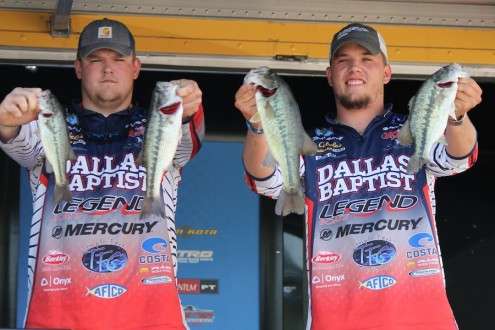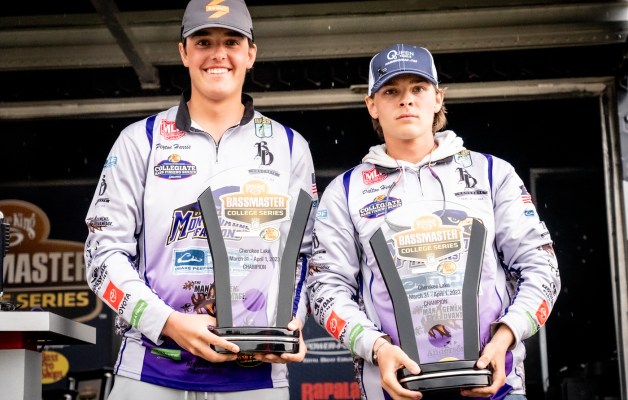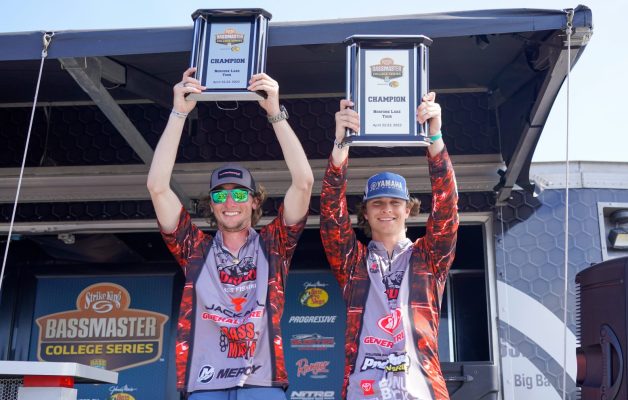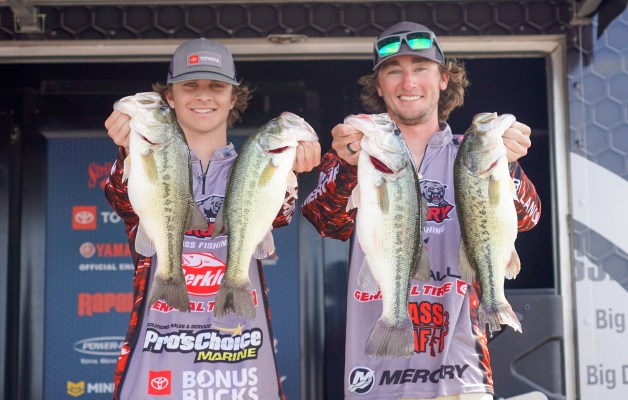
BIRMINGHAM, Ala. — Last week, the Carhartt Bassmaster College Series released its 2014 rankings, and Dallas Baptist University came out on the very top of the list.
“I am ecstatic,” said Cameron Burger, head coach of the Dallas Baptist University Bass Fishing Team and a graduate student at the university.
“This year’s team is what I like to call the A Team,” Burger continued. “We have a different caliber of guys this year. All of them fish tournaments and really know what they’re doing.”
Bass fishing is one of six club sports Dallas Baptist’s athletics department supports, along with swimming, ice hockey, lacrosse, drill and dance, and cheer.
“All of our club sport athletes are treated just like NCAA athletes,” said Connor Smith, interim athletic director and adviser for the team. “They go through the same drug testing, athletic drills and study hall that the NCAA does.”
But how did Dallas Baptist win No. 1 in the rankings when the school did not win the Central Regional, held on Ouachita River earlier this month?
The club’s three teams finished in fifth, seventh and 21st. And the College B.A.S.S. ranking system is built to reward the schools whose entire contingent is strong.
“Every team your school sends to a regional needs to do well,” said Hank Weldon, College B.A.S.S. tournament director, “and DBU did that.”
Each team must be judged on a level playing field, but when the rankings are addressing five regionals and a Wild Card over a five-month period on six fisheries all over the country, you have to work to make it a level playing field. You can’t simply add each college’s overall finish.
This system is not an official ranking system of B.A.S.S. and does not relate at all to the Toyota Bassmaster Angler of the Year rankings or Opens points standings most fans are familiar with. But then, our Elite Series and Opens pros are fishing solo (no team numbers to take into account), and they’re competing on the same lakes at the same time of year with the same field size. Therefore, Angler of the Year and Opens points are simpler to follow.
Comparing a college team’s performance in Florida to one in Louisiana is not apples-to-apples. The College B.A.S.S. ranking system seeks to level the playing field using a series of determinants.
The factors
Here are the four factors we take into consideration: Overall weight, fish weight, BAXAB and field size. These four factors are added together; the sum is each college’s overall score.
1. Overall weight
Each college’s weight per team is averaged out. All the teams competing for one college are added together. The college with the highest average weight per tournament is awarded 1.000. All the other colleges from the same event are awarded a percentage of that weight for their score.
Dallas Baptist University, for example, scored a 1.000 because its three teams at the Central Regional caught 38 1/4 pounds (612 ounces, to keep it simple). Divided by its three teams, its average ounces equal 204. Louisiana Tech University caught 899 ounces, divided by five teams, equaling 179.8 ounces. Therefore, DBU, with the highest ounce average, earned 1.000, and Louisiana Tech earned 0.881 (179.8 ÷ 204 = 0.881).
2. Fish weight
Fish weight works the same way overall weight does. Each college’s average fish weight per team is averaged out, and colleges are awarded a percentage of the 1.000 score.
University of Louisiana at Monroe earned the 1.000 grade from the Central Regional. Take the average number of fish (42 fish ÷ 8 teams = 5.25), and the average weight per team (1,205 ounces ÷ 8 teams = 150.625). Then divide the weight per team by the average number of fish (150.625 ÷ 5.25 = 28.690). Dallas Baptist had an average weight of 24.48 and thus earned a 0.853 score (24.480 ÷ 28.690 = 0.853).
3. BAXAB
This scoring system, created by Bassmaster.com editor Ken Duke, is BAXAB, or Bassing Average X Average Bass. It normalizes the average number of bass caught and the average size of bass caught. In this way, someone who competed in Louisiana against a field of 70 boats — where the winners caught two short of a limit and the winners’ fish averaged 2.4 pounds — can be compared to someone who competed in Florida against a field of 120 — in which the winners caught limits with 4-pound-average bass.
Unlike the other three measures used for College B.A.S.S., 1.000 is not the top score. It is the average score. If you score above 1.000, you’re above average — and below 1.000, you’re below it. Easy enough, right?
To arrive at a score, take the college’s bassing average (the average number of bass brought to the scales each day) and multiply it by the size of the college’s average bass as a percentile of the field’s average bass.
Dallas Baptist scored higher in this category, 2.021, than any other school in all the rankings. Its average number of fish per team (8.333) was multiplied by its average fish weight divided by the average fish weight of everyone else in the tournament (24.48 ÷ 24.792 = .987), and the resulting number (8.225) was divided by the average number of fish caught by team throughout the tournament (4.070), so 8.225 ÷ 4.070 = 2.021.
OK, so maybe not that easy. But it does show how Dallas Baptist’s teams outcompeted other colleges as a whole in the Central Regional, and it dominated more on the Ouachita than other colleges dominated on Okeechobee or Lake of the Ozarks for the Southern and Midwest regionals.
4. Field size
It’s easier to beat 10 teams than it is to beat 100 teams, so the field size measurement takes that into account. All colleges from the same regional get the same score here. All the Southern Regional anglers — which hail from the largest field — earn a 1.000 in this category. All the Central Regional competitors — from the smallest field — earn a 0.597. The number expresses the percentage of the highest field available. Another way to look at it is that Central Regional anglers competed against 59.7 percent of the teams that Southern Regional competitors did.
The Sum
The resulting number is sum of the above factors. Dallas Baptist earned 1.000 for overall weight, 0.853 for fish weight, 2.021 for BAXAB and 0.597 for field size. Its total is 4.471, putting DBU ahead of University of Alabama at 4.410.
Regardless of how the score is calculated, the Dallas Baptist team is excited to be at the top of the list.
“I look forward to the rest of the season and the Carhartt Bassmaster College Series National Championship,” said Burger. “God had a plan, and we just did what we know how to do.”
Stay tuned for the Western Regional coming next month. It and the remaining tournaments will have a significant effect on the College B.A.S.S. rankings.





